Winter Preparedness Checklist for Home

From the south through the north, east to west, nearly the entire country experiences winter weather of some kind. Ice storms across the south. Blizzards that dump snow by the foot along the Great Lakes. Nor’easters along the northern East Coast. Heavy snow in the mountains. Most people don't think of Arizona as a snow state, but Flagstaff is the third snowiest city in the continental USA. Few areas of the United States escape the winter season, though some may never see snow. Even San Diego, a destination known for beautiful weather, has the occasional snow flurry and accumulation.
When news reports warn of an approaching winter storm, some people head out the to the grocery store and stock up on water and food. Footage of empty water aisles are a favorite story for local and national news programs. Other people just ignore the approaching weather and assume they can weather the storm without going to the trouble of preparing.
Some people have a better strategy—winter preparedness. They plan ahead and prepare their family, home, and vehicles ahead of the winter season. No matter where they are when a winter storm approaches, planning head prepares them to deal with just about anything. These are the people you won't meet among the panicked shoppers or the empty grocery store aisles. They already have everything they need.
Standby Generator Fall Maintenance and Winter Preparation
Preparing Your House and Family
 Your family’s home is the most important shelter you have. When bad weather approaches, it becomes the place where your family stays safe, warm, and comfortable. Other places, such as on the road or away from home, are less desirable for numerous reasons.
Your family’s home is the most important shelter you have. When bad weather approaches, it becomes the place where your family stays safe, warm, and comfortable. Other places, such as on the road or away from home, are less desirable for numerous reasons.
Involve all your family in preparing for winter. Talk about your winter emergency preparedness plan and what everyone should do during a winter weather advisory, winter storm watch, or winter storm warning. Everyone should know what to do during hazardous weather and extreme weather conditions including snow, cold, ice, and rain.
Prepare a winter emergency kit for home with supplies and tools that allow you to stay safe and comfortable without risking a trip to the store during bad weather. Throughout the winter, remember to keep your winter emergency supplies stocked and ready. Don’t wait for bad weather to threaten before you check supplies. Make a winter emergency kit list and keep the supplies up to date all year long.
Top 4 Portable Generators for Emergency Home Power
Winter Preparedness Home Preparation
Winter Emergency Preparedness Checklist
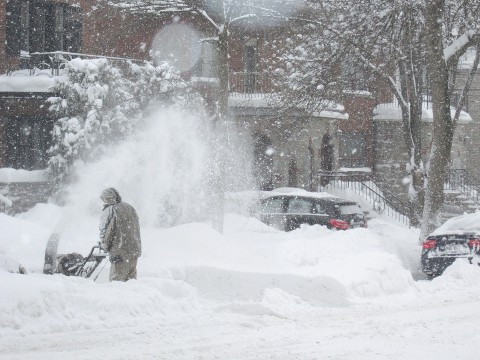
- NOAA Weather Radio – $20 and up for around-the-clock emergency weather alerts. Select one that operates on a wall outlet and batteries. Some can do double duty as a regular radio or clock radio.
TIP: Change the batteries every six months along with your smoke detector batteries. - Install Smoke Detectors and Carbon Monoxide Detectors – Change batteries every six months and test every two months.
- Snow Shovel – Keep one near each door for quick cleanups. Ergonomic shovels can take the pain out shoveling, but not the work. Use caution not to over exert yourself while shoveling.
- Snowblower - Service it before winter so it's ready for the first storm.
- Deicing Compound – A three-month supply of salts suitable for your temperature range to keep porches, stoops, walkways, and drives clear of ice to avoid falls.
- Have your heating system serviced in the fall before the furnace is needed.
- Install weather stripping on doors and windows. Cover leaky windows with clear plastic to keep cold air out—simple-to-install kits are available at hardware stores, big box stores, and home centers.
- Invest in emergency heating equipment meant for indoor use. Kerosene heaters, wood stoves, and electric space heaters.
- Have fireplace and wood stove chimneys cleaned and inspected.
- The Red Cross and the Federal Emergency Management Agency recommend a home backup generator for electrical power. Standby Generators work automatically in all types of weather. Portable Generators are manually connected and operated. Be sure to use portable generators safely.
- Keep at least one chemical fire extinguisher on each level of your home.
- Install an easy to read thermometer indoors.
- Insulate water pipes that are against an outside wall and especially those inside cabinets or other unheated spaces.
Prepare Your Home and Auto for Holiday Travel
Winter Emergency Kit for Home
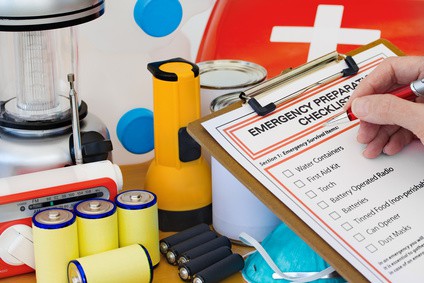
- Keep Prescription Medicines Filled – A five-day supply will cover most emergencies.
- Five-Day Nonperishable Food Supply – Canned meats, soups, stews, cereal, energy bars, beans, etc. Keep a larger supply of baby food, formula, and other baby essentials for infants or toddlers. Maintain a five-day food and water supply for pets.
- Manual Can Opener
- Five-Day Water Supply – 5 gallons per person plus additional for hygiene and flushing the toilet. It takes 1.5 to 3.5 gallons to flush most toilets. Five-gallon buckets with lids are perfect for storing water for washing up and flushing toilets.
TIP: Save wash-up water for flushing. - Flashlights with Two Sets of Batteries – The LED type are brighter and the batteries last longer.
- Cell Phone with Extra Battery – Keep the spare battery charged. Use sparingly in an outage. Check your phone’s settings to enable Emergency Alerts. Bookmark Local Emergency Response Websites on your phone's browser.
- First-Aid Kit – A comprehensive kit that includes more than band aids and aspirin. The Red Cross sells First Aid Kits or gather the supplies and make your own.
- Portable Battery-Operated Radio – Keep up with news and information during a winter emergency.
- Battery lanterns are preferred for emergency lighting. If you use candles, do not leave them unattended. Do not leave small children alone with lit candles.
Use Generators Safely for Winter Emergency Backup Power
Winter Vehicle Preparation and Winter Emergency Car Kit

In January of 2014, a winter storm created a nightmare in and around Atlanta, Georgia when a few inches of snow and ice paralyzed the city and surrounding freeways in gridlock. Commuters were stranded in cars for as long as 18 hours. Following the winter emergency, stories emerged of children who arrived home from school and waited until the next day for their parents.
Georgia officials promised it wouldn’t happen again, but no one has control over the weather. Yet another winter storm struck a year later with fewer problems than the year before, mainly because the department of transportation had prepared for it. You never know where you will be when unforeseen circumstances—like the Atlanta Snowstorm—will leave you stranded for hours or even a day or two.
Preparing your car and your family for winter travel makes being stranded a few hours easier. In some parts of the country, advance preparation can save your life if you’re caught in a blizzard or ice storm farm from home.
Never leave your vehicle to walk in a storm unless you can see someplace to get help within easy walking distance. If that initial destination does not pan out, go back to your vehicle. It is a lot harder to walk in snow, especially with ice underneath.
If your vehicle becomes stuck or disabled, stay with the car. Crack the windows just enough to let some air in. Don't idle for hours with the windows closed. Keep the exhaust pipe clear of snow. A large, three-wick candle placed inside a coffee can raise the temperature inside the car by up to 20 degrees. Keep it where it can't tip over or be knocked over. Make sure any children in the car can't reach it.
Prepare Your Vehicles
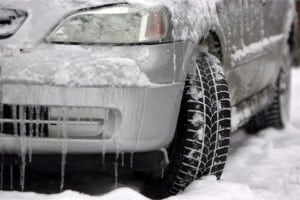
- Check antifreeze and replace according the vehicle maintenance requirements. Perform all other scheduled maintenance before winter arrives.
- Keep the windshield washer fluid topped off.
- Check and replace batteries that are near the end of their life.
- Check the tires for proper inflation. Cold weather lowers the air pressure in the tires.
TIP: A tire inflator doesn't cost much and plugs into an auto outlet. Perfect for keeping your tires at the right pressure. - Replace worn tires nearing the end of their life—balding tires won't grip the road in snow or wet conditions.
- Keep the gas tank above half full to avoid frozen fuel lines.
- Install new wipers and make sure hazard lights are working and ready.
- Install waterproof floor mats – They save the carpet from snow, slush, and salts.
On Vacation: Winter Road Travel Tips
Winter Emergency Car Kit List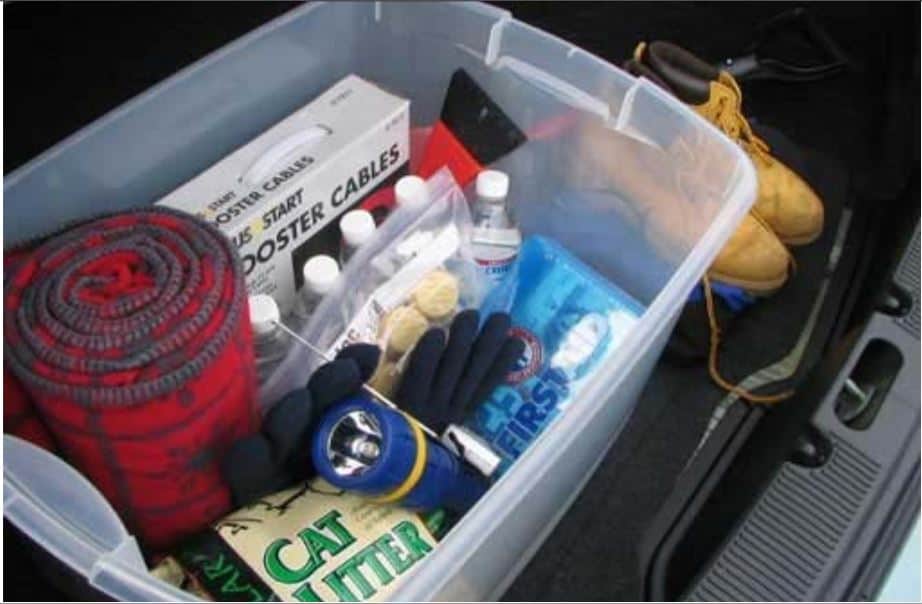
- Small Snow Shovel for Trunk – If you get stuck, free the chassis and wheels before trying to get the car moving again.
- Sand, Salt, and Kitty Litter (non-clumping) – Additional traction if you get stuck. Use it in front or behind the drive wheel, whichever way you’re going.
- Ice Scraper and Brush—Carry at least one gallon of Winter Windshield Fluid.
- Cell Phone Car Charger – Plugs into lighter for charging your cell phone. Keep the phone and spare battery charged.
- Jumper Cables – Refresh yourself on use and look under your own hood at the battery terminals. Red connects to positive (+) and Black to negative ( - ) on both cars.
- Tire chains – The time to figure out how they go on is before you need them. Some parts of the country require chains or studs for winter travel. Check ahead.
- Flares and Reflective Triangles – They draw attention to your car when you are stranded or broken down. Flares are better at night than triangles.
- Fluorescent distress flag – place out your window or tie to antenna to attract attention.
- Tow chain or tow rope rated for your vehicle’s weight.
- Two pair Insulated, Water-Resistant Work Gloves – Protect your hands from the cold and keep them warm and dry if you must work on the vehicle to free it, change a tire, or anything else.
- Flashlight and Two Sets of Batteries – Flashlights with push button switches prevent accidentally turning the flashlight on and draining the batteries. Store batteries in their original packaging to avoid accidental discharge.
TIP: Rechargeable LED Lights are handy and can recharge from your car's USB or Auto Outlet. - First Aid Kit – Keep one in the car for year-around emergency use.
- High Energy Snack Foods – Nut bars, granola, and other non-perishable foods.
- Matches and Three-Wick Candle kept in a Coffee Can with plastic Lid – A three-wick candle can raise the inside temperature of your car as much as twenty degrees. The can will keep wax from spilling. Don’t forget to crack two windows a half inch. Place where it won't be easily knocked over and away from anything that could burn.
- Notepad and Pencil – Write down your name, address, phone number, and destination in the event you decide to leave your vehicle. Don’t leave the shelter of your vehicle without knowing exactly where you are going and how far it is. Your vehicle is your shelter. Carefully assess if you have the strength and energy to make it to another shelter before leaving your vehicle. Don’t leave children or pets behind.
EXPERT ADVICE: Never leave your car in a storm unless you can see your destination. - Include a couple of cold weather sleeping bags. They take up room, but are worth the space if you need them.
Standby Generators Protect Your Home During Winter Outages
Individual Winter Emergency Car Kits
Each Person should have their own winter emergency supplies for traveling. Backpacks make great winter emergency kits because if you must leave your car somewhere, all your essentials are ready to go. Backpacks make it easy for each person can carry their own personal kit.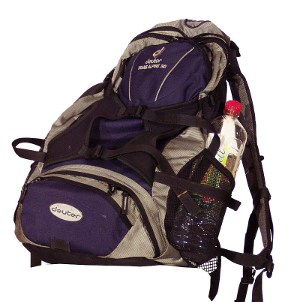
- Winter coat, extra pair of mittens and warm cap. Extra work gloves.
- Wool blanket. Few things beat wool for warmth. Army blankets are inexpensive and warm.
- Insulated, waterproof boots and thermal socks. Thermal underwear.
- High Energy Food. Granola, nuts, peanut butter, protein bars, energy bars, bottled water.
- Cellular Phone with your extra, fully charged battery.
- Adults - Quality Multi-Tool and Pocket Knife.
- Kids – Board games to stay occupied.
- Each person should pack their medications in their own individual emergency bag.
Chances are, you won’t find yourself stranded on the road for more than a few hours, but vehicle breakdowns in a storm can make it difficult for emergency responders to reach you when grid lock leaves a region paralyzed. Being prepared is always better than not preparing at all.
Winter Hazards
Know and understand the different hazards and the weather alerts associated with them. Follow advice. Make sure children are home before bad weather begins and avoid traveling during winter storms. It's a good idea to keep an eye on the weather at all times of the year. Winter can bring some of the nation's most hazardous driving conditions. Knowing the weather forecast will help you make good decisions and may prevent you from ending up stranded somewhere. You'll also know to make sure children are at home rather than somewhere else. Winter weather alerts are typically issued 36 hours ahead of approaching bad weather. An alert means winter weather is expected in the next 12 to 36 hours.
Portable Propane Generators at Norwall
Important Winter Weather Alerts

Blizzard Warning
 Blizzards are the most severe and dangerous winter weather events. They can occur almost anywhere snow falls in significant quantities, although they are relatively rare in the south. In 1993, an extra-tropical cyclone storm formed in the Gulf of Mexico and moved across the Eastern United States. Up to four inches of snow fell in the Florida Panhandle, and Northern Georgia saw 35 inches of snow. Birmingham, Alabama received 13 inches with high winds and a low temperature of just 2 degrees above 0 Fahrenheit. The storm spread up across the South, Appalachia, and East Coast states all the way to New England with snowfall totals ranging from 20 to 45 inches. Power outages during the devastating blizzard affected an estimated 30 million people. The "Storm of the Century" marked the first time the National Weather Service was able to predict with accuracy a storm's severity five days in advance. Warnings were issued two days before the storm struck.
Blizzards are the most severe and dangerous winter weather events. They can occur almost anywhere snow falls in significant quantities, although they are relatively rare in the south. In 1993, an extra-tropical cyclone storm formed in the Gulf of Mexico and moved across the Eastern United States. Up to four inches of snow fell in the Florida Panhandle, and Northern Georgia saw 35 inches of snow. Birmingham, Alabama received 13 inches with high winds and a low temperature of just 2 degrees above 0 Fahrenheit. The storm spread up across the South, Appalachia, and East Coast states all the way to New England with snowfall totals ranging from 20 to 45 inches. Power outages during the devastating blizzard affected an estimated 30 million people. The "Storm of the Century" marked the first time the National Weather Service was able to predict with accuracy a storm's severity five days in advance. Warnings were issued two days before the storm struck.
A blizzard is a period of snowfall with high winds or high winds picking up and blowing the snow on the ground. Blizzards frequently bring whiteout conditions caused by blowing snow and a significant reduction in light. The diffused light during a whiteout causes the loss of depth perception and it becomes impossible to see where you are going or distinguish between the ground and the sky and everything between. The horizon is lost as the white clouds merge with the blowing snow and snow on the ground. People have become disoriented and lost on their own driveways or in their yards. Never leave your vehicle in a blizzard.
A Winter Storm Warning usually accompanies a Blizzard Warning.
How to Prepare for a Power Outage
Key Points - Blizzard Warning:
- Blizzards are Severe and Dangerous Winter Weather Events.
- Blizzard conditions, if not already occurring, will affect the area within 12-26 hours.
- Make preparations for the storm's arrival.
- Check your Winter Emergency Kit and resupply if necessary.
- Do not travel.
- Prepare for possible power outages.
The Best Standby Generators for Winter Emergency Preparedness in Cold Climates
Winter Storm Warning
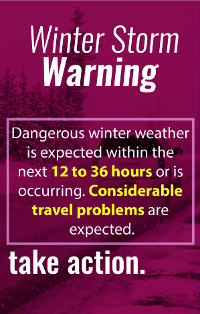 The National Weather Service categorizes Winter Storms as weather events with precipitation that only occurs at lower temperatures including snow, sleet, and freezing rain. Although common during the winter months, winter storms can also occur in the fall and spring. Even more rarely, they can occur during the summer at high altitudes or during an abnormally cold summer such as the one in 1816.
The National Weather Service categorizes Winter Storms as weather events with precipitation that only occurs at lower temperatures including snow, sleet, and freezing rain. Although common during the winter months, winter storms can also occur in the fall and spring. Even more rarely, they can occur during the summer at high altitudes or during an abnormally cold summer such as the one in 1816.
The impact of a winter storm varies depending on the precipitation and where it occurs. In the northern states, significant snowfall makes less of an impact because it is a regular event. State and local agencies are adept at dealing with the snow and residents are familiar with driving and living in cold and snowy conditions. Ice storms and freezing rain are more hazardous. Sleet and freezing rain, sometimes mixed with snow, can create the most hazardous of driving conditions. Ice storms are also responsible for power outages as lines break under the weight of ice and snow or trees that fall on them.
Key Points - Winter Storm Warning:
- A Dangerous Winter Weather Event is occurring or will occur within 12 to 36 hours.
- Prepare for the storms arrival by checking winter emergency supplies and restocking if necessary.
- Winter weather includes snowstorms, freezing rain, rain, and sleet, possibly as a wintry mix of two or more types of precipitation accompanied by freezing or near freezing temperatures.
- Travel is hazardous and should be avoided.
- Power outages may last days as the weather makes it difficult for utility crews to respond to outage reports.
- Top off vehicle fuel tanks ahead of the storm.
What Size Backup Generator - Standby Generator Sizing Guide
Winter Weather Advisory
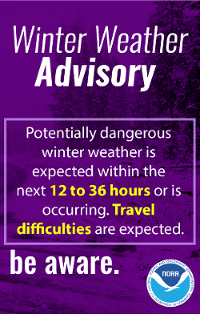 The National Weather Service issues Winter Weather Advisories in advance of a potential for dangerous weather. There is high confidence that potentially dangerous weather is on the way, but the severity is uncertain. Hazards include the possibility for snow, rain, freezing rain, and sleet during periods of lower temperatures. A mix of any or all of the precipitation types may occur. Advisories are issued to make people aware of the potentially dangerous weather. An advisory can turn into a Winter Storm Warning or Blizzard Warning if the severity increases and requires a warning.
The National Weather Service issues Winter Weather Advisories in advance of a potential for dangerous weather. There is high confidence that potentially dangerous weather is on the way, but the severity is uncertain. Hazards include the possibility for snow, rain, freezing rain, and sleet during periods of lower temperatures. A mix of any or all of the precipitation types may occur. Advisories are issued to make people aware of the potentially dangerous weather. An advisory can turn into a Winter Storm Warning or Blizzard Warning if the severity increases and requires a warning.
Key Points - Winter Weather Advisory:
- A potentially dangerous weather event may occur within 12 to 36 hours or is occurring now.
- The potential for ice, snow, freezing rain may make travel dangerous.
- If traveling, plan to arrive at your destination ahead of the weather and allow for extra travel time.
- Travel may become difficult or if the severity of the weather increases, it may become impossible.
- Stay alert to changing winter emergency conditions.
Hurricane Preparedness - Know Your Risks - Make Your Plans
Updated February 1, 2024
